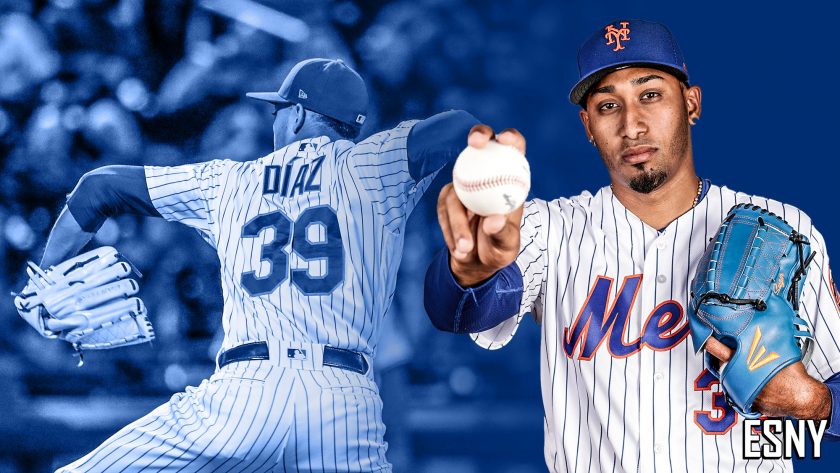New York Mets closer Edwin Diaz earned his short leash in 2020

Following a miserable 2019 campaign, the New York Mets must have a very short leash with Edwin Diaz this season.
Without question, Edwin Diaz failed to play up to his high expectations during the 2019 season.
The 25-year-old was believed to be the solution for the backend of the New York Mets‘ bullpen. Instead, Diaz became a liability during high-leverage situations leading to the loss of his closer role. After his 2018 All-Star campaign, the right-hander endured the worst performance of his entire career.
In his first year as a Met, Diaz recorded a 5.59 ERA (seventh-worst among all relievers with at least 50.0 innings pitched), 4.51 FIP, 3.07 xFIP, 1.38 WHIP, .254 OPP AVG, 39.0% strikeout rate, 8.7% walk rate, 48.8% hard-hit rate and a 26.8% HR/FB rate (both third-highest) along with a career-low 0.0 fWAR rating.
Based on these troubling results from Diaz, the Mets will need to have a backup plan already in place if these numbers continue into this season.
As alternative options to Diaz, the Mets could turn to Seth Lugo and Dellin Betances for save situations in 2020.
While first-year manager Luis Rojas hasn’t officially named Diaz as the closer, the hard-throwing reliever is expected to start off in that role in 2020.
For Diaz to remain as the Mets’ closer this season, he’ll need to drastically improve his command with both his fastball and slider. Over his 58.0 innings pitched in 2019, Diaz generated a .436 SLG (.186 increase from 2018), .339 xSLG (.045 increase), .325 wOBA (.087 increase), .273 xwOBA (.014 increase), along with a 9.4% walk rate (1.2% increase) against his heater.
In addition, the former shutdown closer also allowed seven more home runs off his high 90s fastball during last season. Unfortunately for Diaz, his primary strikeout pitch was also roughed up in 2019.
Diaz’s slider produced a .297 AVG (.168 increase from 2018), .223 xAVG (.021 increase), .622 SLG (.388 increase), .403 xSLG (.218 increase), .387 wOBA (.197 increase), .272 xwOBA (.104 increase), 35.9% strikeout rate (20.5% decrease) and a 43.2% whiff rate (10.6% decrease).
Based on his breaking ball’s dramatic drop in strikeouts, it’s no wonder that Diaz’s overall strikeout rate lowered 5.3% during his 2019 campaign. Unless Diaz improves these concerning metrics this season, he might need a spell in Triple-A to work out his mechanical issues.
If the soon-to-be 26-year-old struggles on the mound once again this season, Rojas will likely turn to Lugo first as the team’s newest closer.
Once former manager Mickey Callaway lost trust in Diaz, Lugo began receiving a lot more save opportunities, starting with his first save of the 2019 season coming on July 26. Overall, the right-hander recorded six total saves last season.
Over his 80 innings pitched in 2019, Lugo pitched to a 2.70 ERA, 2.70 FIP, 3.24 xFIP, 0.90 WHIP, .191 OPP AVG, 33.1% strikeout rate, 5.1% walk rate, 32.8% hard-hit rate, 10.8% HR/FB rate and a 2.2 fWAR rating (fourth-best among relievers with at least 50.0 innings recorded).
Despite pitching just 17.0 innings during the ninth inning last season, Lugo dominated opposing batters. During that span, the 30-year-old reliever didn’t allow any home runs and he generated a 1.59 ERA, 1.10 FIP, 2.62 xFIP, 0.65 WHIP, .153 OPP AVG, 36.9% strikeout rate and a 3.1% walk rate as well. Unlike Diaz, Lugo is also capable of recording six-out saves, as he did during four of his six saves in 2019.
Even if Rojas hands Diaz the closing job coming out of spring training, the Mets will have Lugo waiting for his time to shine if the opportunity presents itself.
If for some reason both Diaz and Lugo struggle to open the season, the Mets will also have Betances as an option for the ninth inning.
While the 31-year-old is coming off a devastating Achilles injury, he’s expected to be fully healthy for when pitchers and catchers are slated to report to camp in less than two weeks.
If Betances can remain healthy throughout the season, he shouldn’t have any issues returning to his previously dominant form.
During his 2018 campaign with the New York Yankees, Betances recorded a 2.70 ERA, 2.47 FIP, 1.95 xFIP (second-lowest among relievers with at least 50.0 innings pitched), 1.05 WHIP, .183 OPP AVG, 42.3% strikeout rate (fourth-highest), 9.6% walk rate, 28.6% hard-hit rate, 20.6% HR/FB rate along with a 1.7 fWAR rating over his 66.2 innings pitched.
[sc name=”lfgm-t-shirt” ]Similar to Lugo, Betances was also extremely successful in the ninth inning during his tenure with the Yankees although the right-hander was never given an opportunity to become the full-time closer.
Since the 2014 season, Betances has produced 36 saves and created a 3.22 ERA, 2.95 FIP, 2.88 xFIP, 1.17 WHIP, .175 OPP AVG, 38.6% strikeout rate, 12.8% walk rate and a 27.7% hard-hit rate over his 81.0 innings of work during the ninth inning.
Based on his impressive results in the ninth inning, Betances could certainly become the everyday closer for the Mets if needed in 2020.
With the Mets looking to surge back into the postseason this year, they’ll need their bullpen to improve from their 4.99 ERA (fifth-worst among all 30 teams) that they produced last season.
Coming out of spring training, Rojas and his staff would love to see Diaz earn his closer role back. But the Mets just can’t afford another disappointing season from their young hurler. If Diaz struggles in March and through April, Rojas can’t be hesitant to pivot to one of the alternatives in Lugo or Betances.






